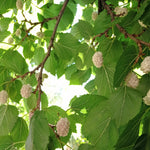Subscribe and save 10%!

White Mulberry (Morus alba)
30 SEK
Unit price perExpected delivery date: 13 December to 20 December.
Applies to orders within Sweden. For other countries - see our delivery terms .
In stock - Ready to be shipped
Share
SEEDS (30pcs/bag)
Common name: White mulberry, White mulberry tree
Scientific name: Morus alba
Family: Moraceae
Plant history & use:
The Mulberry tree is one of the world's oldest cultivated plants - probably best known for hosting silkworms whose threads are used to produce silk fabric, since Mulberry leaves practically are the silkworm's only source of food. And the leaves from the White Mulberry variety are especially popular among the silkworms. The white mulberry originates from West Asia.
The berries on the White Mulberry tree can vary in color - from white to pink to red, to nearly black. The White Mulberries have a sweeter taste than their black-fruited relative Morus nigra . The berries are rich in antioxidants and, like mulberry leaf tea, are thought to help balance blood sugar levels. Thanks to its unusually high nutritional content, mulberries are considered a so-called "superfood", like the goji berry .
Dried white mulberries berries have a caramel-like taste.
In addition, the berries contain the substance MFE, which stabilizes the blood sugar level and thus naturally calms the body's craving for sugar. Therefore, mulberries are a common snack-substitute for those who want to get rid of their sweet tooth.
You can also make juice and jam from the berries.
Culture:
The White Mulberry tree is somewhat hardier than its relative Morus nigra and can withstand temperatures down to -30 ° C. It can grow in most soils but thrives best in loose, nutrient-rich soils. Hardy in windy coastal climates but optimal growth is given in warm, wind-sheltered locations.
Suitable as a trellis tree as the branches are easily bendable.
Mulberry trees also suit well in forest orchards as they are a popular host plant for many organisms and provide recurring harvests without major maintenance and protect plants in lower layers.
Mulberries are self-fertile, which means that only one tree is needed to bear fruit.
Prune in winter when the tree/shrub is dormant to avoid excessive "bleeding" of the tree, which is otherwise a common characteristic of mulberry plants.
The berries ripen continuously from mid-summer to early autumn.
When it's time to harvest, a tip is to pick the berries with a needle to avoid crushing them between your fingers.
Sowing:
Mulberry seeds germinate best if given a cold period of 2-3 months. To induce this, mix the seeds with a small amount of sand/peat/sowing soil and place in a plastic bag in the fridge for the above period. Check periodically if any seeds have germinated in the bag. When the cold period is over, carefully spread the contents of the bag into a pot of soil.
Alternatively, sow outdoors in February in a glass-covered seed bed or greenhouse.
It usually takes 2-4 weeks for the seeds to germinate. However, some seeds may need another 12 months to germinate.
Characteristics:
Lifespan: Perennial
Location: Sun
Height: 1-3 m
Germination Time: 1-12 months
USDA Zone: 4-10
- Choosing a selection results in a full page refresh.
- Opens in a new window.






